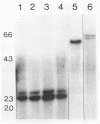Abstract
A set of five mitochondrial (mt) probes derived from a strain of Beauveria bassiana was used to evaluate the similarity of mtDNAs from 15 additional isolates of this fungus and five genera of other entomopathogenic fungi. The probes and genes encoded for (shown in parentheses) were pBbmtE2 (NADI, ATP6), pBbmtE3 (ATP6, small rRNA [srRNA]), pBbmtE4 (srRNA, CO3, NAD6), pBbSE1 (NAD6, tRNAVal, Ile, Ser, Trp, Pro, large rRNA [lrRNA]), and pBbXS1 (lrRNA). The probes produced identical hybridization patterns in EcoRI-digested DNA from nearly all isolates of B. bassiana and Beauveria caledonica. Similar patterns were also observed with Beauveria densa. The isolates of B. caledonica and B. densa DNAs could be differentiated from each other and from B. bassiana on the basis of a HindIII digestion and probing with pBbmtE3. Probe pBbmtE2 produced either a 5.0-kb or a 4.1-kb band in all of the B. bassiana isolates. This observation was used to categorize the mtDNA of B. bassiana into two types, designated A and B. Hybridization of the five probes produced distinct banding patterns in Beauveria brongniartii, Tolypocladium cylindrosporum, Tolypocladium nivea, Metarhizium anisopliae, Verticillium lecanii, and Paecilomyces farinosus. Hybridizations carried out with multiple probes simultaneously present produced unique patterns which characterized the B. bassiana group from all other fungi tested. These results are discussed in terms of how mtDNA polymorphisms in B. bassiana may relate to natural population structures, mt transmission in deuteromycetes, and the use of mtDNA polymorphisms in structural analysis of mtDNA.
Full text
PDF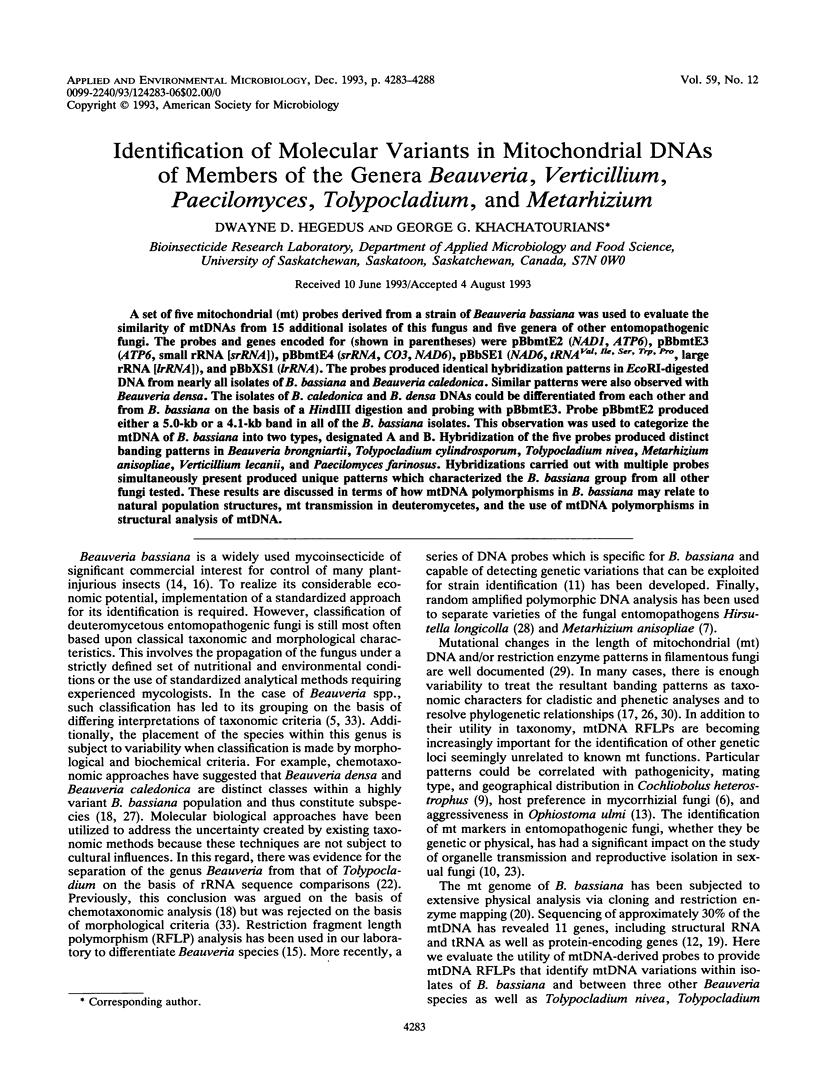
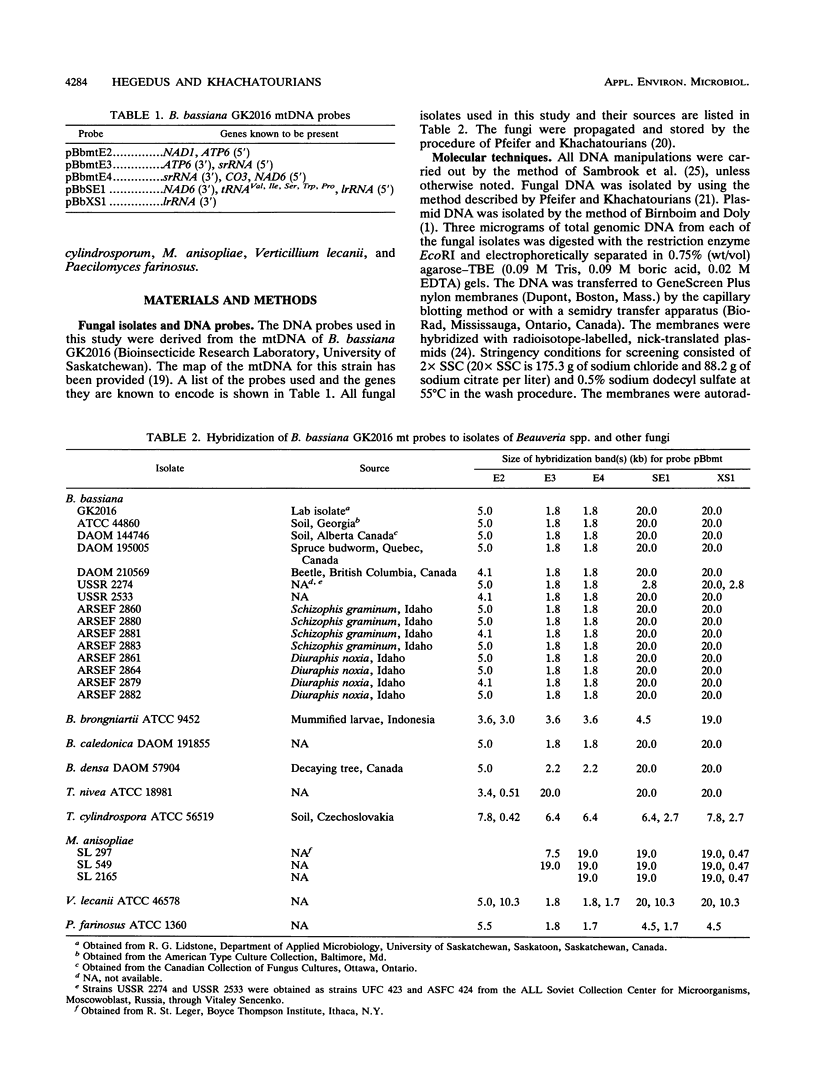
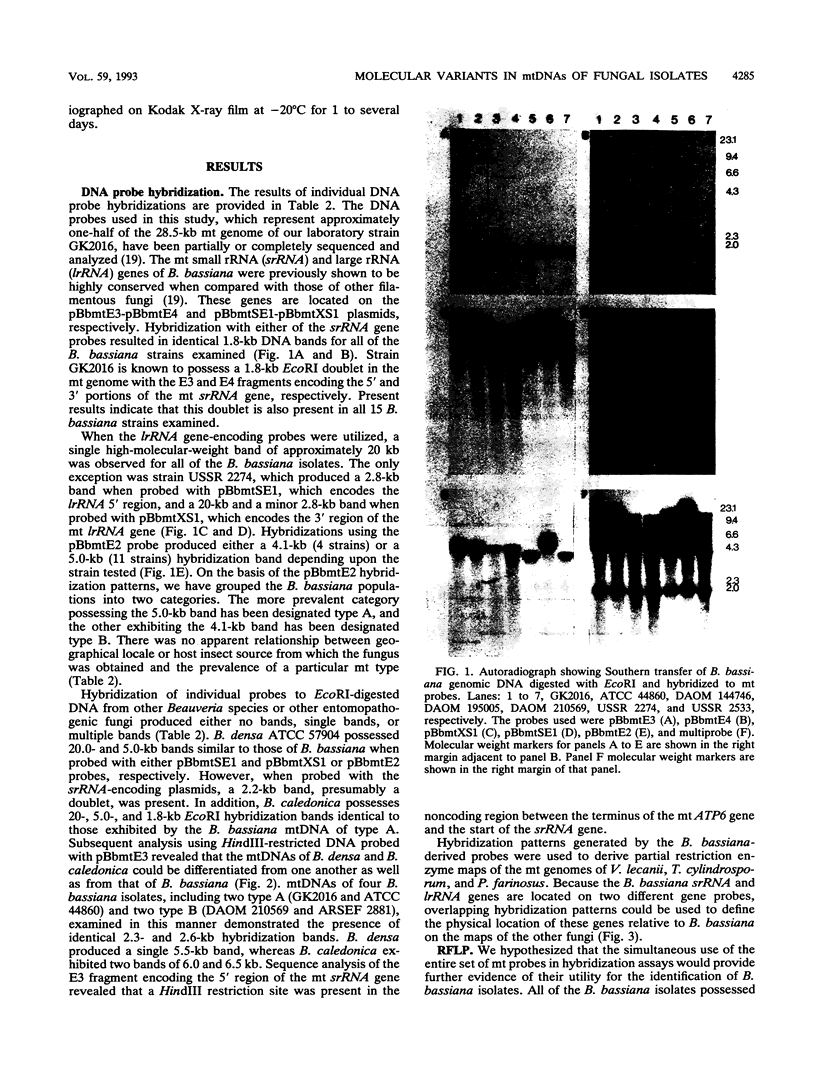

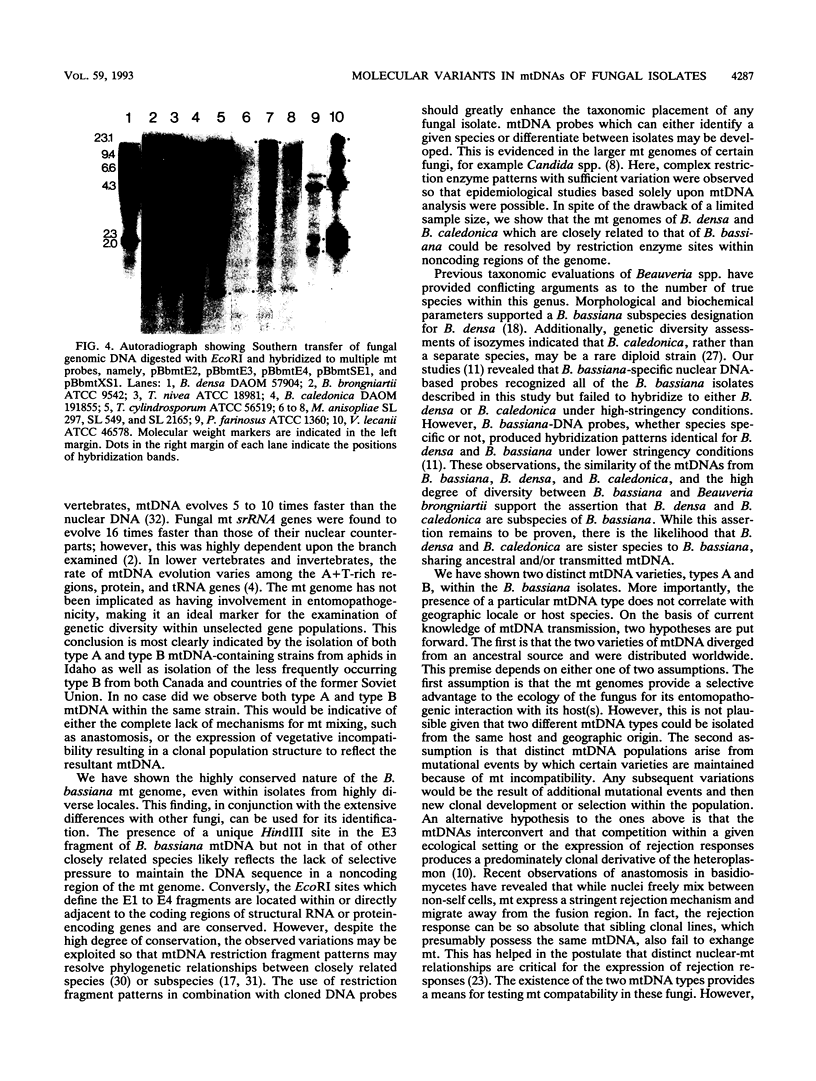
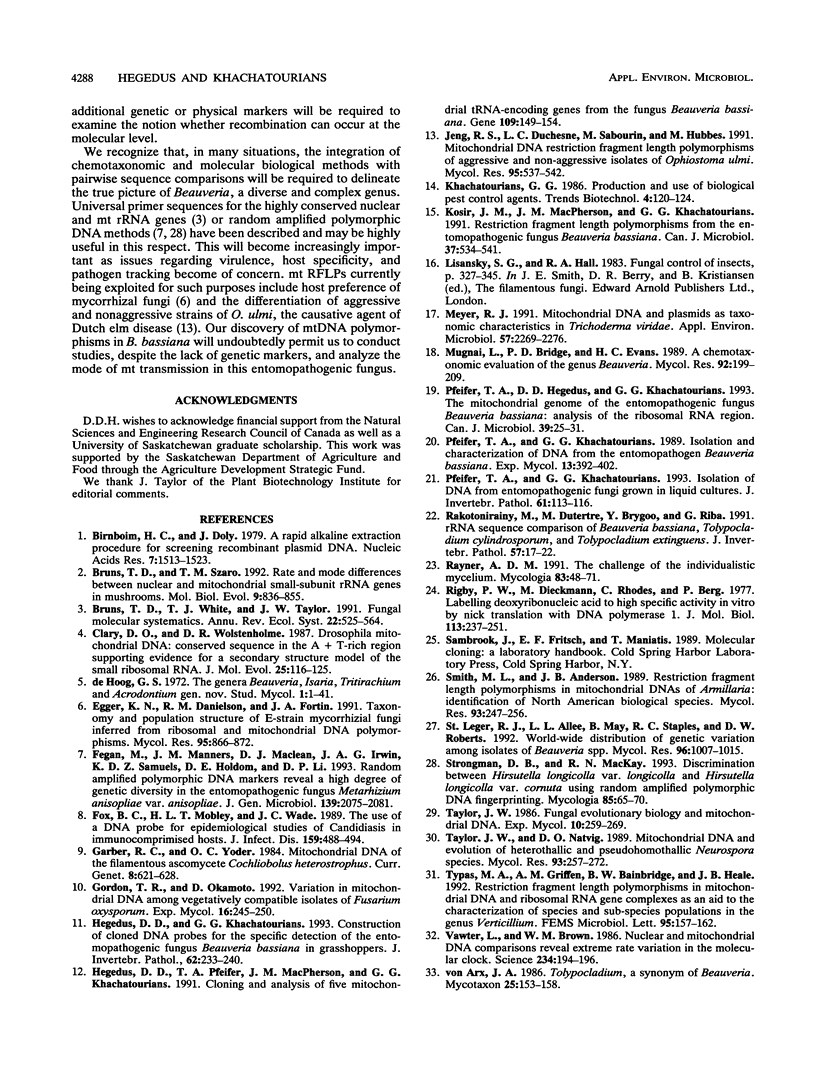
Images in this article
Selected References
These references are in PubMed. This may not be the complete list of references from this article.
- Birnboim H. C., Doly J. A rapid alkaline extraction procedure for screening recombinant plasmid DNA. Nucleic Acids Res. 1979 Nov 24;7(6):1513–1523. doi: 10.1093/nar/7.6.1513. [DOI] [PMC free article] [PubMed] [Google Scholar]
- Bruns T. D., Szaro T. M. Rate and mode differences between nuclear and mitochondrial small-subunit rRNA genes in mushrooms. Mol Biol Evol. 1992 Sep;9(5):836–855. doi: 10.1093/oxfordjournals.molbev.a040760. [DOI] [PubMed] [Google Scholar]
- Clary D. O., Wolstenholme D. R. Drosophila mitochondrial DNA: conserved sequences in the A + T-rich region and supporting evidence for a secondary structure model of the small ribosomal RNA. J Mol Evol. 1987;25(2):116–125. doi: 10.1007/BF02101753. [DOI] [PubMed] [Google Scholar]
- Fegan M., Manners J. M., Maclean D. J., Irwin J. A., Samuels K. D., Holdom D. G., Li D. P. Random amplified polymorphic DNA markers reveal a high degree of genetic diversity in the entomopathogenic fungus Metarhizium anisopliae var. anisopliae. J Gen Microbiol. 1993 Sep;139(9):2075–2081. doi: 10.1099/00221287-139-9-2075. [DOI] [PubMed] [Google Scholar]
- Fox B. C., Mobley H. L., Wade J. C. The use of a DNA probe for epidemiological studies of candidiasis in immunocompromised hosts. J Infect Dis. 1989 Mar;159(3):488–494. doi: 10.1093/infdis/159.3.488. [DOI] [PubMed] [Google Scholar]
- Hegedus D. D., Pfeifer T. A., MacPherson J. M., Khachatourians G. G. Cloning and analysis of five mitochondrial tRNA-encoding genes from the fungus Beauveria bassiana. Gene. 1991 Dec 20;109(1):149–154. doi: 10.1016/0378-1119(91)90601-7. [DOI] [PubMed] [Google Scholar]
- Kosir J. M., MacPherson J. M., Khachatourians G. G. Genomic analysis of a virulent and a less virulent strain of the entomopathogenic fungus Beauveria bassiana, using restriction fragment length polymorphisms. Can J Microbiol. 1991 Jul;37(7):534–541. doi: 10.1139/m91-090. [DOI] [PubMed] [Google Scholar]
- Meyer R. J. Mitochondrial DNAs and plasmids as taxonomic characteristics in Trichoderma viride. Appl Environ Microbiol. 1991 Aug;57(8):2269–2276. doi: 10.1128/aem.57.8.2269-2276.1991. [DOI] [PMC free article] [PubMed] [Google Scholar]
- Pfeifer T. A., Hegedus D. D., Khachatourians G. G. The mitochondrial genome of the entomopathogenic fungus Beauveria bassiana: analysis of the ribosomal RNA region. Can J Microbiol. 1993 Jan;39(1):25–31. doi: 10.1139/m93-004. [DOI] [PubMed] [Google Scholar]
- Rakotonirainy M. S., Dutertre M., Brygoo Y., Riba G. rRNA sequence comparison of Beauveria bassiana, Tolypocladium cylindrosporum, and Tolypocladium extinguens. J Invertebr Pathol. 1991 Jan;57(1):17–22. doi: 10.1016/0022-2011(91)90036-p. [DOI] [PubMed] [Google Scholar]
- Rigby P. W., Dieckmann M., Rhodes C., Berg P. Labeling deoxyribonucleic acid to high specific activity in vitro by nick translation with DNA polymerase I. J Mol Biol. 1977 Jun 15;113(1):237–251. doi: 10.1016/0022-2836(77)90052-3. [DOI] [PubMed] [Google Scholar]
- Vawter L., Brown W. M. Nuclear and mitochondrial DNA comparisons reveal extreme rate variation in the molecular clock. Science. 1986 Oct 10;234(4773):194–196. doi: 10.1126/science.3018931. [DOI] [PubMed] [Google Scholar]




